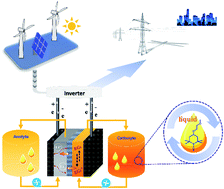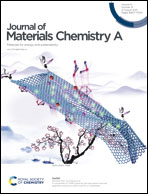TEMPO allegro: liquid catholyte redoxmers for nonaqueous redox flow batteries†
Abstract
Redoxmers are organic active molecules storing energy in redox flow batteries (RFBs). Liquid redoxmers represent an extreme scenario where maximum concentration may be achieved by minimizing supporting solvents, thus maximizing the energy density of RFBs. Herein, a series of (2,2,6,6-tetramethylpiperidin-1-yl)oxyl (TEMPO)-based high potential (catholyte) liquid redoxmers, TEMPO-EG1, TEMPO-EG2, and TEMPO-EG3, were developed by incorporating polyethylene glycol (PEG) chains. Such modifications not only afford dramatic physical changes from solid to liquid and full miscibility in acetonitrile, but also impact the redox behavior. DFT calculations indicate that the incorporated PEG chains impact the charge distribution, which may account for the electrochemical changes. Importantly, compared to our previous liquid catholytes, the new redoxmers exhibit lower viscosity, which is desired for enhancing high concentration cycling performance. By using a hybrid flow cell, TEMPO-EG1 demonstrated more than 70% capacity retention over 100 cycles at 0.1 M and 66% capacity retention at 0.5 M, affording excellent cyclability at various concentrations. The study exemplifies how molecular engineering tuned the rheological properties of redoxmers, such as viscosity, to improve the high concentration cycling performance of RFBs, which may represent a promising avenue for a high energy density and low-cost flow battery system.

- This article is part of the themed collection: Journal of Materials Chemistry A HOT Papers


 Please wait while we load your content...
Please wait while we load your content...
